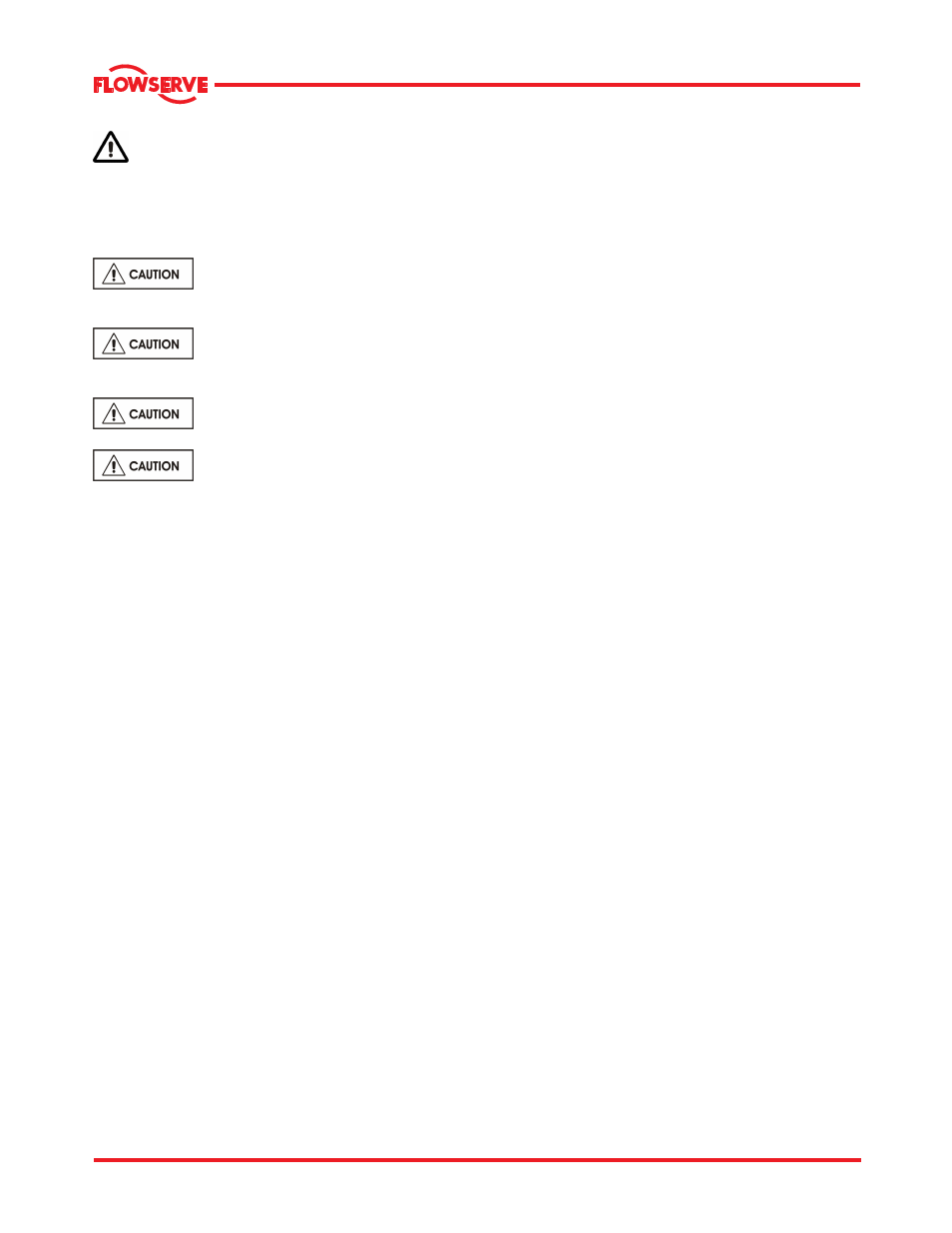Flowserve MNV User Manual
Page 25

MNV & MNZ USER INSTRUCTIONS ENGLISH 71569188 11/04
Page 25 of 47
®
5.5 Guarding
Guarding is supplied fitted to the pump set.
If this has been removed or disturbed ensure that all
the protective guards around the pump coupling and
exposed parts of the shaft are securely fixed.
5.6 Priming and auxiliary supplies
Ensure all electrical, hydraulic,
pneumatic, sealant and lubrication systems (as
applicable) are connected and operational.
Ensure the inlet pipe and pump casing
are completely full of liquid before starting continuous
duty operation.
Prime your pump before starting. Do
not run the pump dry!
Observe extreme caution when
priming , venting and draining hazardous liquids.
Wear protective clothing in the presence of
hazardous, caustic, volatile, inflammable or hot
liquids.
Do not breath the toxic vapors. Do not allow
sparking, flames or hot surfaces in the vicinity of the
equipment
.
Priming a centrifugal pump means removing the air,
gas or vapor from the pump casing and suction
piping. Internal pump parts depend on liquid for
lubrication and may seize if the casing is not
completely filled with liquid prior to starting. Priming
a pump can be accomplished by any of the following
methods, depending on the installation.
5.6.1 Positive suction head (pressure)
With a positive suction head on the pump, priming is
accomplished in the following manner:
a) Open all suction valves to allow liquid to enter the
suction piping and pump casing.
b) Open the vent valve located on the highest point
on the casing (or discharge piping) to release all
entrapped air.
c) When liquid appears as a steady stream (no air
bubbles) the pump is primed and may be started.
5.6.2 Negative suction head (vacuum)
Priming by Ejector or Exhauster
When steam, high pressure water or compressed air
is available, the pump may be primed by attaching an
ejector to the highest point for venting the pump
casing.
Proceed as follows:
a) Open the suction valve.
b) Start the ejector to exhaust the air from the pump
and suction line.
c) When the ejector waste pipe exhausts liquid
continuously, the pump is primed and may be
started.
To ensure that the prime is not lost, allow the ejector
to operate until the pump is started and is up to
operating speed. A continuous stream of liquid will
indicate that the prime is being held.
5.6.3 Priming by vacuum pump
Priming may be accomplished by the use of a wet
type vacuum pump. The procedure is the same as
priming by ejector.
5.7 Starting the pump
5.7.1 Preliminary to starting
Read this instruction book thoroughly before starting
the unit. Make sure the following items are checked
before starting:
a) Pack the stuffing box and leave the gland nuts
loose.
b) Verify alignment has been accomplished as
indicated in section 4.5.
c) Lubricate the driver, as required, per the drive
manufacturer's instructions.
d) Check the direction of rotation of the driver. The
arrow on the pump casing will show the correct
rotation.
e) Lubricate the couplings, as required per the
coupling manufacturer's instructions.
f) Check pump bearing lubrication as indicated in
section 5.
g) The pump must be filled with liquid (primed). If a
priming device is used, it must be operated
before the pump is started.
h) Packing:
•
For packed boxes, the gland nuts must be
loose.
•
Fill the packing grease reservoir if using a
grease packed box, or If the unit is equipped
with an independent flush to the stuffing box,
turn on the flush liquid and verify that the
proper pressure and flow are being supplied.
i)
If the wearing rings are provided with a flushing
provision, turn on the flush liquid
.